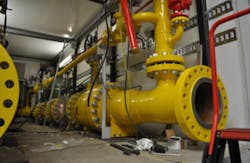A Versatile Solution for Water to Custody Transfer of Natural Gas
Ultrasonic flowmeters were first introduced for industrial use in 1964 by Tokyo Keiki (www.tokyo-keiki.co.jp). The first installation was at a municipal water utility in Itami city, Japan. In the United States, Controlotron (now owned by Siemens, www.industry.usa.siemens.com) brought ultrasonic flowmeters to the United States in the early 1970s. These early ultrasonic flowmeters were of the clamp-on variety, and were used for liquid flow measurement. Then in the 1980s, Panametrics (now part of GE Measurement, www.ge-mcs.com) and Ultraflux in France experimented with the use of ultrasonic flowmeters for gas flow measurement.
In the mid-1990s, as gas flow measurement became more important, the European organization Groupe Europeen de Recherches GaziSres (GERG) published Technical Monograph 8, “Present status and future research on multipath ultrasonic gas flowmeters.” This technical document laid out criteria for using these instruments to measure natural gas flow for custody transfer. Its publication gave a major boost to the sales of multipath ultrasonic flowmeters for natural gas in Europe. Soon after this, in 1998, the American Gas Association (AGA, www.aga.org) approved AGA-9, a standard for the use of multipath ultrasonic flowmeters for custody-transfer applications. Since that time, the use of ultrasonic flowmeters for custody-transfer applications has continued to increase. Other meters for this purpose include differential pressure and turbine.
Even though most ultrasonic flowmeters were of the clamp-on type when they first came out, inline meters have come to dominate the ultrasonic market in the past 10 years. Inline meters have certain advantages over clamp-on meters. Because the transducers are mounted in the wall of the meter body, the ultrasonic signal doesn’t have to go through the pipe wall as it does with the clamp-on style. The pipe wall can attenuate the signal, which reduces measurement accuracy. The width of the pipe wall is also an issue for clamp-on meters, and any build-up in the pipe wall can also impact the inside diameter of the pipe. This can also affect the accuracy of the measurement.
Suppliers have attempted to improve the performance of ultrasonic flowmeters by bringing out flowmeters with increased numbers of paths. While it is clear that multipath flowmeters with three or more paths are more accurate than single- and dual-path meters, increasing the number of paths does not automatically increase measurement accuracy. Many multipath ultrasonic meters have four, five, or six paths. These are manufactured by Emerson Process Management (www.emersonprocess.com), Elster Instromet (www.elster-instromet.com), FMC Technologies (www.fmctechnologies.com), and Sick (www.sick.com). However, Caldon (a division of Cameron, www.c-a-m.com) has manufactured ultrasonic flowmeters with eight and 12 paths, while Faure Herman’s ultrasonic meter has 18 paths. (Faure Herman, www.faureherman.com, is a division of IDEX Corporation.) Most of the Caldon and Faure Herman meters are for liquid petroleum applications, although Caldon has recently released a multipath meter for natural gas.
While research will continue on making multipath ultrasonic flowmeters more accurate and reliable, both for liquids and gases, one issue that remains unresolved is that of recalibration. There is currently no consensus among suppliers and end-users about how often an ultrasonic flowmeter should be recalibrated. The purpose of recalibrating a meter that has already been in service is to make sure it is reading correctly. This is especially important for ultrasonic flowmeters doing custody transfer, but it applies to meters used for other applications as well.
While some countries have established their own standards about recalibration, the topic has not been taken up by the American Gas Association (AGA, www.aga.org) or the American Petroleum Institute (API, www.api.org). This is an important topic for end-users, since recalibrating a meter usually means pulling it out of service and shipping it to a calibration facility. Without a generally accepted standard, many end-user companies have chosen to set their own time periods for recalibration. Onsite interviews with oil and gas companies in the Middle East reveal that most end-users choose to recalibrate their ultrasonic flowmeters anywhere from every 3–7 years. The topic of ultrasonic flowmeter recalibration is now under study by Flow Research in conjunction with Colorado Engineering Experiment Station, Inc. (CEESI,www.ceesi.com), with the aim of producing a guideline in the near future.
For more information on Flow Research’s work in the area of ultrasonic flow measurement, visit FlowUltrasonic.com.



